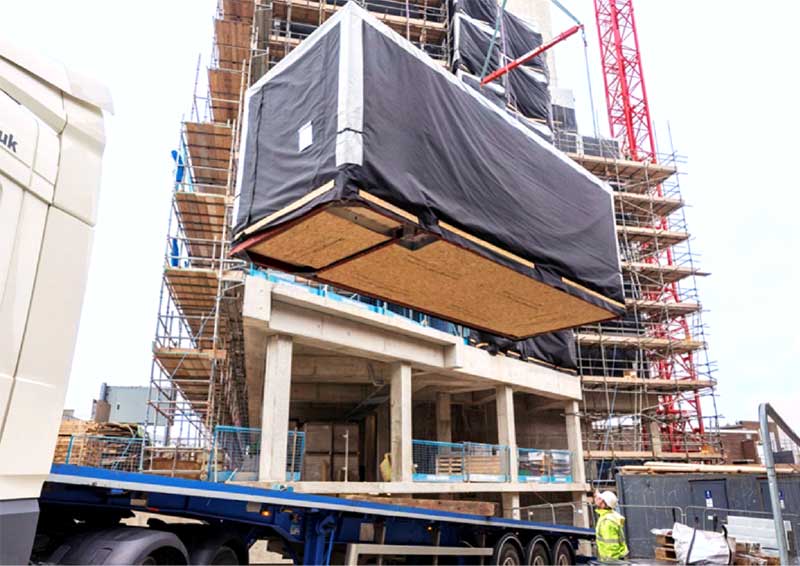Offsite manufacturing and standardised design
Contents |
[edit] Introduction
The UK construction industry is facing two key issues: a skills shortage and an increasing demand for improved infrastructure.
The 2016 government-commissioned Farmer review identified that the number of skilled workers in the industry is likely to decline by at least 20% over the next decade.
Offsite construction using standardised factory-made components has the potential to reduce the current risks to future infrastructure delivery. As seen in the housing sector it offers shorter programmes and reduced costs coupled with higher outputs and more consistent quality. The reduction of head-count on site also improves health and safety.
But though offsite is well suited to large housing schemes the often linear nature of infrastructure projects and programmes and their greater geographical spread are perceived as barriers to offsite delivery.
[edit] Need for standard designs
Traditionally bridges, retaining walls and other transport infrastructure assets are designed on a bespoke, site-specific basis. As a result, there is a lack of repetition.
Motorway gantries are a good example of where standardisation has been possible allowing the benefits of offsite fabrication to be realised. Standard design families have been created that are adjustable for specific locations but allow automated design and manufacturing processes, which in turn improves buildability and reduces cost.
Similar processes could be used for road and rail bridge construction – but there is added complexity due to greater variation in loading, geometry and aesthetic influences. Geotechnical interactions can also be diverse, particularly where integral construction leads to complex soil-structure interaction.
To realise the benefits of offsite for infrastructure, a compromise is needed from what might traditionally have been considered an ‘optimised design’. Small concessions made in designing bridges to standard skews, or to modules of fixed span length, will most likely be offset by productivity benefits. It would allow the use of standardised components (including multiple-use of expensive precast moulds), that lend themselves to automated digital engineering, manufacturing and traceability.
[edit] Attractive working environments
Offsite also enables many construction activities to be moved into climate-controlled, dry factories that are safe and pleasant places to work in compared to remote, weather-exposed site locations. In time this could lead to a growing number of construction workers, with the industry once again becoming attractive.
There is also great potential to minimise exposure of the workforce to road and rail traffic and associated safety hazards. Issues such as lifting heavy manufactured units and temporarily stabilising them during assembly need to be carefully addressed, but familiarisation and practice will bring its own safety benefits.
As well as greater education on how the industry can further utilise offsite construction, close collaboration in the design process between clients, designers, contractors and manufacturers is also important.
With a move towards increased early contractor involvement as a form of procurement, and the opportunities currently presented by the major infrastructure projects in the UK, the civil engineering industry is now at a point where it can and must seize the opportunity to change and modernise. This means adopting standardised offsite construction.
This article was originally published here on 24 Jan 2018 by ICE. It was written by John Armitage, Ramboll.
--The Institution of Civil Engineers
[edit] Related articles on Designing Buildings Wiki
- Articles by ICE on Designing Buildings Wiki.
- Building Skills for Offsite Construction.
- Design for Manufacture and Assembly (DfMA).
- How to make projects off-site ready.
- Modular buildings.
- Off-site construction.
- Off site, on track.
- Off-site prefabrication of buildings: A guide to connection choices.
- Offsite manufacturing.
- Platform approach to design for manufacture and assembly.
- Prefabrication.
Featured articles and news
The UK's Modern Industrial Strategy: A 10 year plan
Previous consultation criticism, current key elements and general support with some persisting reservations.
Building Safety Regulator reforms
New roles, new staff and a new fast track service pave the way for a single construction regulator.
Architectural Technologist CPDs and Communications
CIAT CPD… and how you can do it!
Cooling centres and cool spaces
Managing extreme heat in cities by directing the public to places for heat stress relief and water sources.
Winter gardens: A brief history and warm variations
Extending the season with glass in different forms and terms.
Restoring Great Yarmouth's Winter Gardens
Transforming one of the least sustainable constructions imaginable.
Construction Skills Mission Board launch sector drive
Newly formed government and industry collaboration set strategy for recruiting an additional 100,000 construction workers a year.
New Architects Code comes into effect in September 2025
ARB Architects Code of Conduct and Practice available with ongoing consultation regarding guidance.
Welsh Skills Body (Medr) launches ambitious plan
The new skills body brings together funding and regulation of tertiary education and research for the devolved nation.
Paul Gandy FCIOB announced as next CIOB President
Former Tilbury Douglas CEO takes helm.
UK Infrastructure: A 10 Year Strategy. In brief with reactions
With the National Infrastructure and Service Transformation Authority (NISTA).
Ebenezer Howard: inventor of the garden city. Book review.
The Grenfell Tower fire, eight years on
A time to pause and reflect as Dubai tower block fire reported just before anniversary.
Airtightness Topic Guide BSRIA TG 27/2025
Explaining the basics of airtightness, what it is, why it's important, when it's required and how it's carried out.
Construction contract awards hit lowest point of 2025
Plummeting for second consecutive month, intensifying concerns for housing and infrastructure goals.
Understanding Mental Health in the Built Environment 2025
Examining the state of mental health in construction, shedding light on levels of stress, anxiety and depression.























